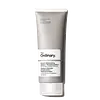What's inside
What's inside
 Key Ingredients
Key Ingredients

 Benefits
Benefits

 Concerns
Concerns

 Ingredients Side-by-side
Ingredients Side-by-side

Water
Skin ConditioningCaprylic/Capric Triglyceride
MaskingCetyl Ethylhexanoate
EmollientIsodecyl Neopentanoate
EmollientGlycerin
HumectantPropanediol
SolventPolyglyceryl-6 Polyricinoleate
EmulsifyingHydrogenated Vegetable Oil
EmollientPolyglyceryl-2 Isostearate
EmulsifyingIsosorbide Dicaprylate
Skin ConditioningDisteardimonium Hectorite
StabilisingPhytosteryl Canola Glycerides
Skin ConditioningGlycosphingolipids
EmollientGlycolipids
Skin ConditioningLinoleic Acid
CleansingOleic Acid
EmollientPalmitic Acid
EmollientStearic Acid
CleansingArginine
MaskingGlycine
BufferingAlanine
MaskingSerine
MaskingProline
Skin ConditioningThreonine
Glutamic Acid
HumectantLysine Hcl
Skin ConditioningBetaine
HumectantXylitylglucoside
HumectantAnhydroxylitol
HumectantXylitol
HumectantGlucose
HumectantMaltose
MaskingFructose
HumectantTrehalose
HumectantSodium PCA
HumectantPCA
HumectantSodium Lactate
BufferingUrea
BufferingAllantoin
Skin ConditioningSodium Hyaluronate
HumectantLecithin
EmollientTriolein
Skin ConditioningDimethyl Isosorbide
SolventPentylene Glycol
Skin ConditioningTocopherol
AntioxidantHydroxymethoxyphenyl Decanone
Skin ConditioningCitric Acid
BufferingTrisodium Ethylenediamine Disuccinate
Magnesium Sulfate
Sodium Chloride
MaskingSodium Hydroxide
BufferingPhenoxyethanol
PreservativeChlorphenesin
AntimicrobialWater, Caprylic/Capric Triglyceride, Cetyl Ethylhexanoate, Isodecyl Neopentanoate, Glycerin, Propanediol, Polyglyceryl-6 Polyricinoleate, Hydrogenated Vegetable Oil, Polyglyceryl-2 Isostearate, Isosorbide Dicaprylate, Disteardimonium Hectorite, Phytosteryl Canola Glycerides, Glycosphingolipids, Glycolipids, Linoleic Acid, Oleic Acid, Palmitic Acid, Stearic Acid, Arginine, Glycine, Alanine, Serine, Proline, Threonine, Glutamic Acid, Lysine Hcl, Betaine, Xylitylglucoside, Anhydroxylitol, Xylitol, Glucose, Maltose, Fructose, Trehalose, Sodium PCA, PCA, Sodium Lactate, Urea, Allantoin, Sodium Hyaluronate, Lecithin, Triolein, Dimethyl Isosorbide, Pentylene Glycol, Tocopherol, Hydroxymethoxyphenyl Decanone, Citric Acid, Trisodium Ethylenediamine Disuccinate, Magnesium Sulfate, Sodium Chloride, Sodium Hydroxide, Phenoxyethanol, Chlorphenesin
Water
Skin ConditioningColloidal Oatmeal
AbsorbentGlyceryl Stearate Citrate
EmollientCetyl Alcohol
EmollientGlyceryl Stearate Se
EmulsifyingCaprylic/Capric/Myristic/Stearic Triglyceride
EmollientButylene Glycol Dicaprylate/Dicaprate
EmollientButyrospermum Parkii Butter
Skin ConditioningOctyldodecanol
EmollientGlycerin
HumectantPolysorbate 20
EmulsifyingCetearyl Alcohol
EmollientDecyl Glucoside
CleansingTheobroma Cacao Seed Butter
EmollientAvena Sativa Kernel Extract
AbrasivePrunus Armeniaca Kernel Oil
MaskingCamellia Sinensis Leaf Extract
AntimicrobialChrysanthemum Parthenium Extract
Skin ConditioningGlycyrrhiza Glabra Root Extract
BleachingHippophae Rhamnoides Extract
MaskingVanilla Planifolia Fruit Extract
Skin ConditioningZingiber Officinale Root Extract
MaskingLactobacillus Ferment Lysate
Skin ConditioningBisabolol
MaskingVanillin
MaskingPolysorbate 60
EmulsifyingXanthan Gum
EmulsifyingDimethicone
EmollientPotassium Sorbate
PreservativePhenoxyethanol
PreservativeTetrasodium EDTA
Water, Colloidal Oatmeal, Glyceryl Stearate Citrate, Cetyl Alcohol, Glyceryl Stearate Se, Caprylic/Capric/Myristic/Stearic Triglyceride, Butylene Glycol Dicaprylate/Dicaprate, Butyrospermum Parkii Butter, Octyldodecanol, Glycerin, Polysorbate 20, Cetearyl Alcohol, Decyl Glucoside, Theobroma Cacao Seed Butter, Avena Sativa Kernel Extract, Prunus Armeniaca Kernel Oil, Camellia Sinensis Leaf Extract, Chrysanthemum Parthenium Extract, Glycyrrhiza Glabra Root Extract, Hippophae Rhamnoides Extract, Vanilla Planifolia Fruit Extract, Zingiber Officinale Root Extract, Lactobacillus Ferment Lysate, Bisabolol, Vanillin, Polysorbate 60, Xanthan Gum, Dimethicone, Potassium Sorbate, Phenoxyethanol, Tetrasodium EDTA
 Reviews
Reviews

Alternatives
Ingredients Explained
These ingredients are found in both products.
Ingredients higher up in an ingredient list are typically present in a larger amount.
Glycerin is already naturally found in your skin. It helps moisturize and protect your skin.
A study from 2016 found glycerin to be more effective as a humectant than AHAs and hyaluronic acid.
As a humectant, it helps the skin stay hydrated by pulling moisture to your skin. The low molecular weight of glycerin allows it to pull moisture into the deeper layers of your skin.
Hydrated skin improves your skin barrier; Your skin barrier helps protect against irritants and bacteria.
Glycerin has also been found to have antimicrobial and antiviral properties. Due to these properties, glycerin is often used in wound and burn treatments.
In cosmetics, glycerin is usually derived from plants such as soybean or palm. However, it can also be sourced from animals, such as tallow or animal fat.
This ingredient is organic, colorless, odorless, and non-toxic.
Glycerin is the name for this ingredient in American English. British English uses Glycerol/Glycerine.
Learn more about GlycerinPhenoxyethanol is a preservative that has germicide, antimicrobial, and aromatic properties. Studies show that phenoxyethanol can prevent microbial growth. By itself, it has a scent that is similar to that of a rose.
It's often used in formulations along with Caprylyl Glycol to preserve the shelf life of products.
Water. It's the most common cosmetic ingredient of all. You'll usually see it at the top of ingredient lists, meaning that it makes up the largest part of the product.
So why is it so popular? Water most often acts as a solvent - this means that it helps dissolve other ingredients into the formulation.
You'll also recognize water as that liquid we all need to stay alive. If you see this, drink a glass of water. Stay hydrated!
Learn more about Water